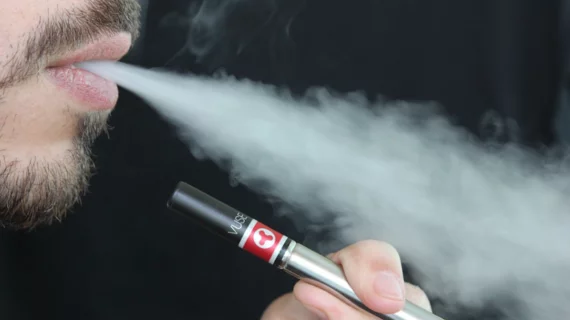A study published this week in Radiology used MRI scans to examine how the lungs react differently to vaping and smoking.
Based on the imaging from 44 healthy participants before and after smoking tobacco/vaping, researchers found that tobacco exposure decreased lung perfusion, while vaping led to an increase. These effects were observed after just one smoking/vaping session. Given that many smokers turn to vaping as a means of smoking cessation, it is important to understand how each method affects the function of the lungs.
“Contrary to nicotine replacement therapy, a higher proportion of smokers who successfully quit tobacco smoking and were supported by electronic nicotine delivery systems (ENDS) continue to use ENDS beyond the point of successful smoking cessation,” Sylvia Nyilas, from the Department of Diagnostic, Interventional and Pediatric Radiology at the University Hospital of Bern in Switzerland, and co-authors wrote. “Although the use of ENDS is increasing on a global scale, there are limited data regarding the short- and long-term effects of ENDS usage on the lung.”
Compared to cigarettes, vaping has a safer risk profile. However, its side effects, such as increased heart rate and blood pressure are similar to that of conventional cigarettes. But how does each method affect the lungs?
To find out, researchers used non-contrast enhanced matric pencil magnetic resonance imaging and lung function tests. A total of 44 healthy participants (10 control participants, nine former tobacco smokers, 13 ENDS users, and 12 active tobacco smokers) underwent both exams before and immediately after exposure to ENDS products or tobacco smoke. Baseline measurements were taken after two hours of product abstinence and post-exposure measurements were taken directly after smoking sessions.
After tobacco exposure, MRI revealed a decrease in perfusion but no significant differences in fractional ventilation. Conversely, ENDS exposure caused an increase in perfusion, but likewise, no fractional ventilation changes. Only tobacco exposure led to increased lung clearance indexes (in the majority of participants), and no participants recorded a change in spirometry indexes.
The authors noted that the elevated lung clearance indexes could be due to small airways disease that is caused by tobacco exposure. They also pointed out that some ENDS users had e-liquids that contained nicotine, and some did not. Those who did have nicotine in their e-liquids experienced increased local perfusion impairment.
The effects of smoking and vaping are unique. It is especially important, the experts suggested, that more research on the long-term effects of vaping be conducted, as there are still many unknowns compared to traditional cigarette smoking.
“To our knowledge, long-term consequences of perfusion changes in healthy individuals are unknown and should be investigated,” the authors wrote. “These preliminary results suggest that MRI indexes may be considered as a noninvasive test to complement pulmonary function testing in this setting.”
More content related to the effects of smoking:
Ultrasound images reveal how smoking before conceiving impacts embryonic development
MRI scans reveal bigger brains in people with optimal cardiovascular health
ACR seeking changes to CMS proposal that would expand eligibility for CT lung cancer screening

